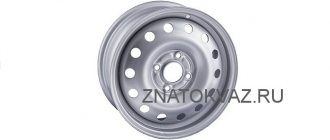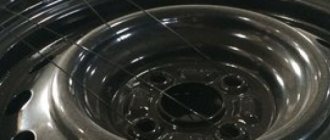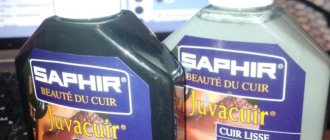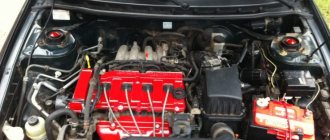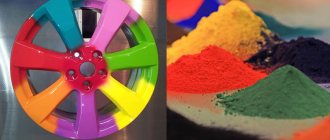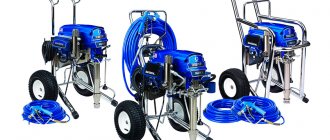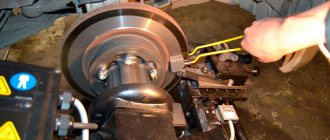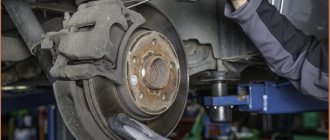Looking for a way to improve the aesthetics of your car? You can start by changing the color of your wheel rims and protecting them from rust and scratches. Painting the wheels with liquid rubber will help solve these issues. The flexible rubber coating, commonly used for car paint, can last up to three years. A durable rubber coating (Plasti-Dip, Runway or other brands) protects the rims from external factors (sun, frost and salt).
Self-painting of wheels with liquid rubber
Plasti-Dip comes in dozens of colors and gives your wheels a nice matte finish that is sure to enhance the aesthetics of your vehicle. This article provides step-by-step instructions for correctly and effectively applying liquid rubber to rims.
What is liquid rubber
The easiest way to paint wheels yourself is with plastidip. This type is easy to apply to all types of metals. It doesn’t matter whether it’s stainless steel or cast iron, carbon steel or aluminum. The composition holds equally firmly and looks beautiful.
Composition – bitumen-polymer emulsion made of two components. It can be applied to any surface and has seamless waterproofing properties. Hardens quickly, special conditions for application are not required.
However, it should not be confused with bitumen mastic. Although the properties are partially the same, rubber has differences. I'll start with the usual properties of any rubber:
- Elasticity;
- Easily withstands blows;
- No chips left;
- It is not washed off with water and does not allow moisture to reach the metal;
- Resistant to elevated temperatures;
- Good resistance to slipping;
- Durable in use;
- You can find any color you want.
In addition, there are properties inherent only to liquid rubber:
- Ready to use immediately (no need to wait, warm up, etc.);
- Easy to apply.
These qualities have made it popular in the market. Liquid rubber is produced both in sprays (aerosol cans) and in cans. Applies as easily as paint. It can be removed as easily as film. Able to penetrate difficult to reach places.
This is an excellent alternative to gluing vinyl films. Films are difficult to stick to the complex shaped surface of disks, but rubber does not require even or smooth surfaces.
Can be removed without damaging the coating on which it was applied.
Dyeing process
Clean, dry, prepared discs - you can proceed directly to painting yourself.
Please note: Choosing a compressor for painting a car
How to do this - step-by-step instructions . The can should be held at a distance of 40–50 cm perpendicular to the surface. The correct angle of inclination will help avoid the appearance of shagreen (pimply surface).
- Applying the first layer - the surface is covered with rubber in a shallow layer, so that the main (factory) color is visible, let it dry for 10-15 minutes.
- Second layer. This time, liquid rubber is applied more specifically - all areas of the disc are painted thoroughly and evenly. Having finished re-painting, the paint is allowed to dry again, leaving it for the same period.
- Applying the third layer is an almost completed procedure. Now, on the rubber-painted and dry surface of the disc, the paint is sprayed so thoroughly that the disc looks finished. Before applying the final, fourth layer, the paint is again allowed to dry thoroughly.
- After 10–15 minutes, it’s time for the finishing touches. The fourth layer is to bring the surface of the disc to an ideal state. Then comes the turn of final drying and the final stage.
After waiting for the liquid rubber to dry completely, which is about two hours, you can begin to remove the tape. This is done carefully - the protective layer is removed gradually, without making sudden jerks, so as not to damage the fresh coating. Cards are deleted faster.
The average consumption of Plasti Dip for four wheels with a diameter of 17 inches is 2-3 cylinders.
A little advice! During the preparatory work, place the can of paint in a bucket of warm water - heating promotes uniform spraying, without convulsive “spitting”.
Painted disc
Types of liquid rubber
The cost of the product varies, it all depends on the manufacturer. There are budget coverage options, and there are very expensive ones. You can cover the rims (and other elements) of the car yourself, or you can contact a service center where they will do everything for you.
The most popular rubber is in a can. They are much cheaper than canned ones and come in a wide variety of colors and textures. Plasti Dip is considered the market leader; it is an American brand. In addition to sprays, manufacturers package liquid rubber in cans or buckets.
Purchasing buckets or cans is more economical, however, for application you need special equipment - a spray gun and a compressor, or an electric sprayer. It is not recommended to apply it with a brush; it will not create a smooth and uniform layer.
The can version is more suitable for covering the entire bottom of the car, or the entire body. That is, for large volumes of coverage. For rims, a spray is sufficient.
The most accessible, well-known and popular types of liquid rubber are:
- Plasti Dip. Produced in America, in the form of 400 ml cans. In addition to the standard color palette, there are special ones, for example, mother of pearl, metallic or chameleon. It is very easy to remove and apply. Suitable for painting and as protection against scratches or chips.
- Air Dip. Analogue of the American product, Chinese release. The scope of application is the same, but Chinese products are limited in colors and variety of textures. It has no glossy shades at all.
- Liquid Rubber Coating. The cheapest coverage option. The structures are only matte, but the color palette is unlimited. Also produced in 400 ml cans.
What is plastidip, its technical properties and characteristics
Wheels are painted with liquid rubber using plastidip, a material that can be easily applied to various types of metal, be it stainless steel, carbon steel, cast iron or aluminum. The main advantage of the material is the ability to remove the applied layer without harming the discs and without auxiliary tools. In addition, the material presented:
Why are discs covered?
What does such coverage provide, is there any benefit or is it a collective farm show-off? This type of tuning is considered not a simple decoration:
- Rubber provides additional protection against moisture, scratches and chips on metal. Scratches on the disc occur from pebbles flying from under the wheels;
- This is a design method of giving a car a unique style, not prohibited by law;
- A good way to hide disc defects, scratches, chips, small dents, and give them a new life;
- Applying a spray from a can will cost less than replacing discs or contacting a service center for painting.
How much should I buy?
If you paint 4 discs with a spray, how many cans will be needed in total? Many authors forget to answer this crucial question. Meanwhile, you need to take into account that the coating is applied in 5-7 layers. The options are:
- 2 cans of spray should be enough for 4 discs if the coating is 5-7 layers;
- If you want a final layer of a special color, then add another can of final coating, the previous layers will serve as a strong base;
- For large and patterned rims, it is recommended to take one can per wheel.
To summarize, I will say that it all depends on your skill and the number of layers applied; for a car - a passenger car, you need a maximum of 4 bottles of spray.
Preparation
Any driver who has already dealt with painting wheels knows that such work is carried out indoors without dust and debris, which easily stick and spoil the appearance. Wheel rims also require preparation before coating:
- It is necessary to clean the discs from dirt, dust, oil flows and debris.
- The treated surface is dried and degreased with a solvent.
After this, you can spray the rubber. If the liquid is sprayed unevenly, it is not recommended to rub it with a rag so that the fibers do not get on the coating. It is better to buy anti-silicone, which is freely sold in any spare parts store.
Do-it-yourself painting of wheel rims is always justified?
Wheels are one of the most aggressive parts of a car. This is natural given the fact that they are wheels. Additionally, unlike a car's paintwork, factory wheels are painted using a much simpler process that does not provide adequate protection over many years of use.
In addition, unlike car paint, factory painting of rims is carried out using a much simpler technology, which does not provide adequate protection over many years of use.
It is worth noting that installing modern alloy wheels is also not a “panacea” for corrosion. Of course, a “cast” disc is more resistant to external factors, but the main protective role in this case is coating the discs with a special varnish.
The destruction of the protective layer leads to the appearance of corrosion spots, which appear in the form of whitish pits, the number of which increases every year. Such corrosion may not have a significant effect on the structure of the disc, but it greatly spoils the appearance of the car.
Of course, you can restore the wheels to their original appearance by contacting specialized painting services, but you can do this procedure yourself. In this case, there is no need to paint the wheels even for the garage - to carry out this procedure, you can do it in your own apartment.
So, we’ll talk about how to paint wheels with your own hands in this article.
Basic technologies for painting rims
To begin with, we must determine exactly what we want to achieve by painting the rims. Of course, this is a “representative” appearance and a sufficient level of corrosion protection.
Based on these criteria, as well as the type of wheels (stamped or cast), we need to choose a painting method. Technologies in this case differ not only in the way the work is performed, but also in the level of protection.
Very often you have to make a compromise in terms of protection and appearance. And if in the case of “stamping” it makes sense to focus on maximum protection, then in the case of cast light alloy wheels it makes sense to take a closer look at the painting methods, revealing the dials as elegantly as possible. So what are the painting methods?
Using primer and auto enamel
This method is the easiest to use and, if the painting technology is followed, provides fairly good protection against rust. The downside to this technology is that it is mainly used for stamped steel wheels.
Painting wheels with liquid rubber
It is ideal for maximum corrosion protection but does not offer a wide range of color options. This is the ideal solution for all car enthusiasts who value performance and protection over appearance.
Use of powder paints
This is the best choice for car owners with alloy wheels.
Chrome plating
Technically, this is the most complex technique, thanks to which the boards look very impressive.
As you can see, there are quite a few ways to paint wheels, and we will try to consider them for ourselves. home delivery.
Do-it-yourself painting of discs
Having understood the painting technology, you can proceed directly to the purchase of painting materials and work. Let's start with the simplest method - painting shields using conventional techniques.
— Self-painting of alloy wheels:
For this we need a primer and auto enamel. They can be purchased in the form of ready-made cans at any auto parts store.
In this case, the efficiency of the work will depend on how effectively you can pre-clean the disk from dirt and old paint.
The easiest way is to use an electric drill and a special metal disk brush.
After cleaning the plate, degrease it with a solvent, let it dry and prime it. After the primer has dried, the enamel should be applied to the slab in several layers, each layer being pre-dried.
This method is the simplest and most suitable for stamped discs.
Otherwise, the painting technique is much more complicated and, let’s say right away, more adequate to the conditions in a car service center. However, if you wish, you can make them yourself.
Until now, the most effective method of painting both cast and stamped wheels is the so-called polymer or powder painting.
To apply the appropriate polymer, you will need a special paint gun with an electrostatic effect, as well as a polymerization chamber at a temperature of about two thousand degrees Celsius.
It is clear that you will not be able to carry out such a procedure on your own, so we will turn to simpler and quite effective methods.
For this method it is necessary to paint the wheels with liquid rubber. This is done with special “rubber” paints, which are also sold in cans. Their difference lies in the limited range of colors (most often liquid rubbers are available in black and white) and the rough texture of the coating.
To paint rims yourself with liquid rubber, first prepare the rim for painting in the same way as for regular car paint, that is, sand, degrease and prime.
There is no need for a primer in this case, since rubber paint serves as both a primer and a protective coating, and adheres very well to various materials.
instructions for painting panels with liquid rubber:
When painting, be careful not to leave any traces of rust on the dial. They can be removed by grinding and using special anti-corrosion agents, which are also sold in auto parts stores.
Apply the paint evenly in several layers, trying not to leave streaks on the surface and maintain a constant distance from the gun to the target surface.
Immersion printing (painting discs in a bath of water)
In recent years, a completely new technology has appeared on the service market - painting slabs in a water bath. Scientifically, this is called dip printing, and it allows you to apply any texture or image to your wheels using special foil.
This chapter describes in detail the process of painting rims in a water bath:
In this case, the protective function is performed by a layer of base coating, which is applied in advance before applying the design, as well as a varnish that is used to cover the slab after completion of processing.
The technology of immersion printing on wheels requires basically the same preparation of the disk in the form of sanding and painting with the original (base) varnish.
After sanding and drying, the plate is immersed in a warm water bath (it is important to maintain the temperature balance recommended by the foil manufacturer), and then foil with the appropriate imprint is applied to the plate.
shows that painting wheels with your own hands in a bath of water is not always successful the first time:
After removing the board and drying it, it is covered with a layer of protective varnish, and after drying, the board should be polished with felt discs and a fine-grained abrasive paste.
Liquid rubber
The dyeing industry has recently replaced conventional dyes with a new modern product called liquid rubber.
The substance is applied to the factory paintwork, being an alternative to classic car enamels and vinyl films.
The application technology is not complicated and allows you to paint the entire car or individual parts, for example, rims, without significant costs.
Liquid gum is a putty consisting of two components. The main ingredient is a bitumen-polymer microemulsion. Does not contain solvents specific to each paint.
Thanks to this, it does not emit harmful volatile compounds.
In the case of manual coating of metal surfaces of wheel rims or car bodies, the substance is applied to the surfaces by spraying from a spray bottle.
Benefits of coverage
By covering car wheels with a multilayer rubber emulsion, drivers receive the following benefits:
- reliable protection against anti-icing reagents;
- shockproof properties;
- UV resistance;
- flexibility, nice design of the outer shell;
- dustproof, resistant to temperature changes;
- easy disassembly and replacement if necessary;
- easy application by hand;
- there are no special complaints about the place where the work is performed;
- does not require careful preparation: sanding, priming;
- strong adhesion to chrome, plastic;
- Damaged rubber layers can be quickly repaired by reapplication.
We complete all work within 12 hours. Each hand-applied layer dries within an hour.
A reliable protective coating is maintained on the most complex configurations of auto parts, which is why rubber coating of wheel rims is becoming increasingly popular among motorists.
The removed layer of rubber does not leave marks on the surface of the boards, unlike decorative protective films.
Preparation
There are two brands of liquid rubber on the Russian market:
- Rubber paint is produced jointly by Russia and China.
- Plasti Dip is made in the USA.
The substance is sold in aerosol packaging and cans. Balloon liquid mixtures are more expensive, but their convenience is undeniable when painting with your own hands, and moreover, it does not require a lot of material to cover small areas.
Carrying out the necessary work:
- safety glasses, respirator;
- sharp knife;
- compressor and spray gun;
- PVC film, masking tape, cardboard, a stack of old newspapers;
- paint solvent.
The room temperature should be maintained at 18-20 ° C, cleaned, dust and dirt should be removed, and everything around should be moistened with water. The room must be equipped with exhaust ventilation.
Before you start working with your own hands, wash and dry the discs. After removing the rust and oil layer, the surfaces of the parts are degreased with anti-silicone.
Application technology
The DIY map of applying liquid rubber to wheels contains the following steps:
- The emulsion is applied in small sections using a nozzle located perpendicular to the plane of the disk at a distance of 130-170 mm.
- Start by applying a thin layer of foundation and then spread it evenly. Don't try to write everything down at once. Each application needs to dry for at least half an hour.
- Re-application should be done slowly, more precisely, while maintaining 70% transparency. Transitions and stripes are noticeable on the surface.
- The third, fourth and so on are applied to two dried layers. Their number is equal to the required result. Professionals recommend applying ten to twelve layers.
- Pre-dry the discs for an hour.
Final drying is carried out indoors without drafts for at least 24 hours. The capacity of one can is 400 g of paint. The approximate consumption of Plasti Dipu when applied to each layer is 50-80 g per 1 m2:
- radius 13, 14, 15, 16" - two cans;
- Radius 17, 18, 19, 20" - from 3 to 5 cans.
Treating wheels made by yourself gives you truly excellent results. The parts are always like new and are not exposed to harmful external factors. Dirt rolls off on them, and it is convenient to treat small scratches with a regular spray. The car continues to please its owner.
Application methods
For a better coating, rubber is applied at temperatures above +5 in the room; if the room temperature is below +20, you can hold the can for a short time in warm water. Shake first, like any substance in a can. There are several application methods:
- The most popular method has become the dipping method for wheels. With this method, the outer edge of the tire is covered with masking tape. At the same time, the joints between the disc and the rubber are painted. The color of liquid rubber is chosen to match the color of the tires, and the result is a visual merging of the tire with the rim.
- The use of cardboard pieces to cover all unnecessary elements. They are easy to insert and then easy to remove once the rubber is applied.
- You can seal areas that do not require rubber coating using regular tape. Only this process is more labor-intensive and it’s difficult not to get tape on the disc.
- The easiest way. It is recommended to cover only the wheel valve. The costs for pasting are minimal. Unnecessary rubber residues fly off after several washes. It’s easy to remove plastidip from unnecessary places; it comes off with pieces of film.
New wheels do not need painting, but painting after repair or used wheels is necessary. For more details, read my article “do-it-yourself repair and painting of alloy wheels.”
Why should it be used?
Smooth rubber combines practicality and aesthetics, so it can be considered as the best solution for painting panels or other elements. Moreover, the application of Plastidypu is quite easy because there is no need to prepare the area previously. If you want, even a beginner can change the appearance of your car.
Using liquid rubber has many advantages, including
- low costs;
- Ease of use and versatility;
- Ability to use on different types of surfaces;
- Finished coatings are several times thicker than conventional coatings;
- Rubber paint perfectly masks defects and protects the surface from damage;
- Wide range of colors;
- Possibility to draw a disk without dismantling the wheels;
- resistance of liquid rubber to external influences;
- Easy to remove shell (does not leave marks on discs).
Please note! A suitable smooth rubber painting will allow you to eliminate disc imperfections and finish them earlier.
Rules
There are simple rules for applying rubber that must be followed:
- A total of 5-7 layers are applied to each disc, with one application;
- It is better to apply the first layer by spraying;
- On the second pass, pay more attention to the corners and spokes;
- Subsequent passes are needed to increase the thickness and strength of the layer;
- Rubber is applied at angles of 60-90 degrees;
- Damaged areas with noticeable defects can be passed separately several more times to smooth them out and hide them under the thickness of the layer;
- Drying of the first layer is about 15 minutes, subsequent layers are 30-40 minutes;
- It is recommended to dry a fully treated wheel for another day.
Unsuccessfully applied rubber can be carefully torn off from the surface, without harm to it, and applied again. I have everything, my friends. Now you can handle the coating of rims with rubber yourself, decorating your car. I recommend reading my article “Do-it-yourself repair and painting of stamped wheels.” Subscribe to updates on the site and share the link with your friends.
